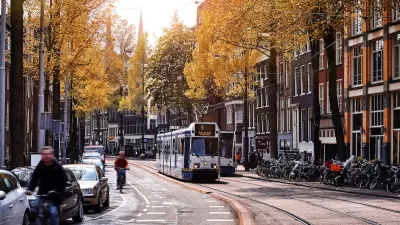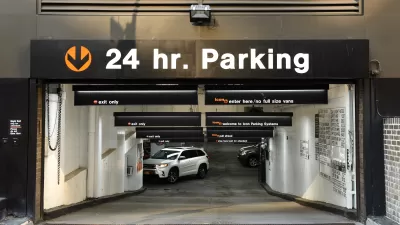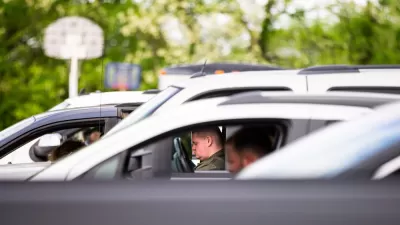Planners strive to anticipate future needs, which sometimes creates self-fulfilling prophecies: by preparing for a situation we help cause it. This is particularly true of automobile dependency. Planning decisions intended to accommodate automobile.
Planners strive to anticipate future needs, which sometimes creates self-fulfilling prophecies: by preparing for a situation we help cause it. This is particularly true of automobile dependency. Planning decisions intended to accommodate automobile travel can create a cycle of increased vehicle travel, more automobile-oriented planning, and reduced alternatives. This concept is conveyed brilliantly in the cartoon below, drawn by transportation engineer Ian Lockwood and published in the March 2012 ITE Journal.

The alternative to automobile dependency is not necessary a total lack of private vehicles (i.e., carfree communities), rather, it is a multi-modal transport system, which allows people to choose the best option for each trip: walking and cycling to reach local destinations, public transport for travel on major corridors, and automobile travel when it is truly best overall.
Decision-makers generally don't try to create automobile dependency, but many current planning practices unintentionally stimulate it. Wider roads, higher vehicle traffic speeds, increased parking requirements, and destinations located along major highways don't just facilitate automobile access, by degrading walking and cycling conditions (an impact called the barrier effect) and increasing distances between destinations they reduce access by other modes.
Automobile dependency imposes large costs on users and society. It forces people to drive even for local errands, such as transporting children to school. It makes public transit inefficient and inconvenient. It increases the costs of vehicles, parking facilities and roads borne by households, businesses and governments, as well as traffic congestion, accidents and pollution problems. It is inequitable and inefficient: it makes non-drivers significantly worse off and forces motorists to chauffeur non-driving family members and friends.
A good way to begin reducing automobile dependency is by implementing school transport management programs, which help make walking and cycling safer and more convenient. This is good in many ways: children who can walk or bike to school are healthier, happier and learn better than those who do not, and helps break the cycle of parents feeling obliged to drive because of the perceived risks of non-motorized travel.
Another good practice is for anybody involved in transport system planning to spend at least a couple weeks each year without driving, so they can experience the transport system they are creating from non-drivers' perspective. They will probably find that walking, cycling and public transit travel are sometimes enjoyable, but often frustrating due to incomplete networks, inadequate services, and poor connections – some of which can be corrected inexpensively.
The challenge for planners is to avoid traps, such as self-fulfilling prophesies and unintended consequences, which fails to create the future that we really want.
For More Information
Jeffrey R. Brown, Eric A. Morris and Brian D. Taylor (2009), "Paved With Good Intentions: Fiscal Politics, Freeways, and the 20th Century American City," Access 35 (www.uctc.net), Fall 2009, pp. 30-37; at www.uctc.net/access/35/access35.shtml.
Complete Streets (www.completestreets.org) is a campaign to promote roadway designs that effectively accommodate multiple modes and support local planning objectives.
Santhosh Kodukula (2011), Raising Automobile Dependency: How to Break the Trend?, GIZ Sustainable Urban Transport Project (www.sutp.org); at www.sutp.org/dn.php?file=TD-RAD-EN.pdf.
Todd Litman (2011), The First Casualty of a Non-Existent War: Evaluating Claims of Unjustified Restrictions on Automobile Use, and a Critique of 'Washingtons War On Cars And The Suburbs', Victoria Transport Policy Institute (www.vtpi.org); at www.vtpi.org/carwars.pdf.
Peter Newman and Jeffrey Kenworthy (1999), Sustainability and Cities; Overcoming Automobile Dependency, Island Press (www.islandpress.org).
Peter Samuel and Todd Litman (2001), "Optimal Level of Automobile Dependency; A TQ Point/Counterpoint Exchange with Peter Samuel and Todd Litman," Transportation Quarterly, Vol. 55, No. 1, Winter 2000, pp. 5-32; at www.vtpi.org/OLOD_TQ_2001.pdf.
SDC (2011), Fairness in a Car Dependent Society, U.K. Sustainable Development Commission (www.sd-commission.org.uk); at www.sd-commission.org.uk/pages/fairness-in-a-car-dependent-society.html.
Scott Sharpe and Paul Tranter (2010), "The Hope For Oil Crisis: Children, Oil Vulnerability And (In)Dependent Mobility," Australian Planner, Vol. 47, No. 4, December, pp. 284-292; summary at http://dx.doi.org/10.1080/07293682.2010.526622.
Dennis Soron (2009), "Driven To Drive: Cars And The Problem Of 'Compulsory Consumption'," Car Troubles: Critical Studies of Automobility and Auto-Mobility (Jim Conley and Arlene Tigar McLaren eds), Ashgate (www.ashgate.com), pp. 181-196; www.ashgate.com/isbn/9780754677727.
Ming Zhang (2006), "Travel Choice with No Alternative: Can Land Use Reduce Automobile Dependence?" Journal of Planning Education and Research, Vol. 25, No. 3, pp. 311-326; http://jpe.sagepub.com/cgi/content/abstract/25/3/311.
Thanks to Ian Lockwood for sharing his cartoon.

Alabama: Trump Terminates Settlements for Black Communities Harmed By Raw Sewage
Trump deemed the landmark civil rights agreement “illegal DEI and environmental justice policy.”

Planetizen Federal Action Tracker
A weekly monitor of how Trump’s orders and actions are impacting planners and planning in America.

Why Should We Subsidize Public Transportation?
Many public transit agencies face financial stress due to rising costs, declining fare revenue, and declining subsidies. Transit advocates must provide a strong business case for increasing public transit funding.

Understanding Road Diets
An explainer from Momentum highlights the advantages of reducing vehicle lanes in favor of more bike, transit, and pedestrian infrastructure.

New California Law Regulates Warehouse Pollution
A new law tightens building and emissions regulations for large distribution warehouses to mitigate air pollution and traffic in surrounding communities.

Phoenix Announces Opening Date for Light Rail Extension
The South Central extension will connect South Phoenix to downtown and other major hubs starting on June 7.
Urban Design for Planners 1: Software Tools
This six-course series explores essential urban design concepts using open source software and equips planners with the tools they need to participate fully in the urban design process.
Planning for Universal Design
Learn the tools for implementing Universal Design in planning regulations.
Caltrans
Smith Gee Studio
Institute for Housing and Urban Development Studies (IHS)
City of Grandview
Harvard GSD Executive Education
Toledo-Lucas County Plan Commissions
Salt Lake City
NYU Wagner Graduate School of Public Service






























